Wind:
Reading to date:
At this point you have hopefully read the chapter on Wind from David's book before we start this discussion. This is a dense chapter that explores the basics of wind power.
Underlying Concept: Energy Generation Density
Before we dive too much into the specifics of wind power we need to sort out this idea of average power/energy generation/m2. Consider this analogy. You are considering buying a 30 hectare (150 acre) hay farm near Madras. In order to figure out your possible cash flow it helps if you know the average number of tons of hay for each acre (tons/acre) you can grow annually. It will not be the same for every part of the farm and you might have a different number for the irrigated fields relative to the dry land area. Some fields may give you 2 tons/hectare (4 tons/acre) and some may give you less that 1 ton/hectare. Knowing these numbers and how many tons of hay you need allows you to project the balance between your production and your need. Thats why these are useful numbers.
Compared to traditional power generation almost all renewable energy sources take up space. Whether it's wind turbines that have to be spaced some distance apart to avoid interfering with air flows to solar systems which need to be covered with panels that take up space. As a first step it is helpful to have a sense for the relationship between the energy generated and the space used. Because we already have many operating wind generation facilities we have data that we can use to determine this important number.
In part this allows us to compare different uses or forms of renewable energy generation. By comparing the energy or power generation/m2 for different options we can get a sense whether it makes more sense to grow corn which can be made into oil or ethanol and burned in a generator or install solar panels on the same ground.
Power Generation Density Calculation:
Here's how it works. Imagine we have a technology which can generate 10 W/m2 on average. Because this is an average it means that we can generate energy at this rate (do the units confirm this is a rate?) every minute of every day, night and day, for the whole year. How much energy can I generate over a year if I have 100 m2 to work with (this is about the size of a big roof on a house)?

At $0.10/kWh that is worth about $870 a year. Because we are comparing all of our numbers to our average use of 250 kWh/p/d it would be helpful to divide this annual value by 365 to get
Daily Energy Generation = (8.7.103 kWh/yr)/(365 d/yr) = 24 kWh/d
So, is that a lot of energy? What to compare it to? This is about 10% of our daily needs which is nothing to sneeze at. Another way to look at it is that (looking at your 'power' bill) most Americans use about 1000 kWh/month for their homes. That means a energy source that could generate 10 W/m2 could provide enough energy over a year to offset your household energy use for 9 months. Seems pretty good yes?
Take Away:
10 W/m2 is a very good power generation density for renewable energy!
Our Personal Share:
The next thing we need to be sure have a collective understanding of is what David means when he states that there are 4000 m2/person (m2/p) for each person in the UK. The underlying concept is that our national renewable energy discussion is a collective discussion that assumes we're sharing in the effort and the results. Again, some parts of any country have more space available for solar and wind power but the average allows us to make useful comparisons between countries or regions. We got numbers like [3.4.105m2/p: Crook; 2.0.105m2/p: Jefferson; 4.0.104 m2/p: Deschutes] when we did the unit conversion HW problem a couple of weeks ago. Nationally the number is 2.4.104 m2/p if we leave Alaska out of the discussion.
HW: Wind
In Britain David Mackay calculates that there are about 4000 m2 of land area per person. We will calculate the average land area available per person for the whole country in class. If we thought of Oregon as it's own “country” how much area is available per person in Oregon? Is this bigger or smaller than an average house lot which is 680 m2? Is this bigger or smaller than a standard Central Oregon ranchlet (5 acres) which is 20,000 m2 ?
How Much Will We Use?
David makes a big point early in his book that he is going (mostly) start by considering the most optomistic vision of what we might be able to generate from renewable energy sources. The most (ridiculous) view would be that we would carpet the country with wind turbines or solar panels or both. This seems so unrealistic that David backs away from his original assertion and considers that it's pretty optomistic that we would cover 10% of the country with some form of renewable energy generation. For the UK this means 400 m2/p and in the US as a whole this would be 2400 m2/p. You can already see one of the big distinctions between the UK and the US which is that we just have a lot more space available for whatever it is that we might do (6x as much!)
The Grid:
It will come up in a variety of contexts so here a good place to start that discussion. Where do we make electric energy and how does it get from there to our homes and businesses?
This graphic from an article by the Washington Post is a good reminder of where we generate our energy in this country. You may notice that, to some extent, most of the power generation takes place close to where most people live. There are some important exceptions to notice. There is a lot of hydropower in the NW which sees out of proportion to the population. Even more so are the coal and wind power in places like Wyoming and Montana which have very small populatios. This is why we have the 'grid'!
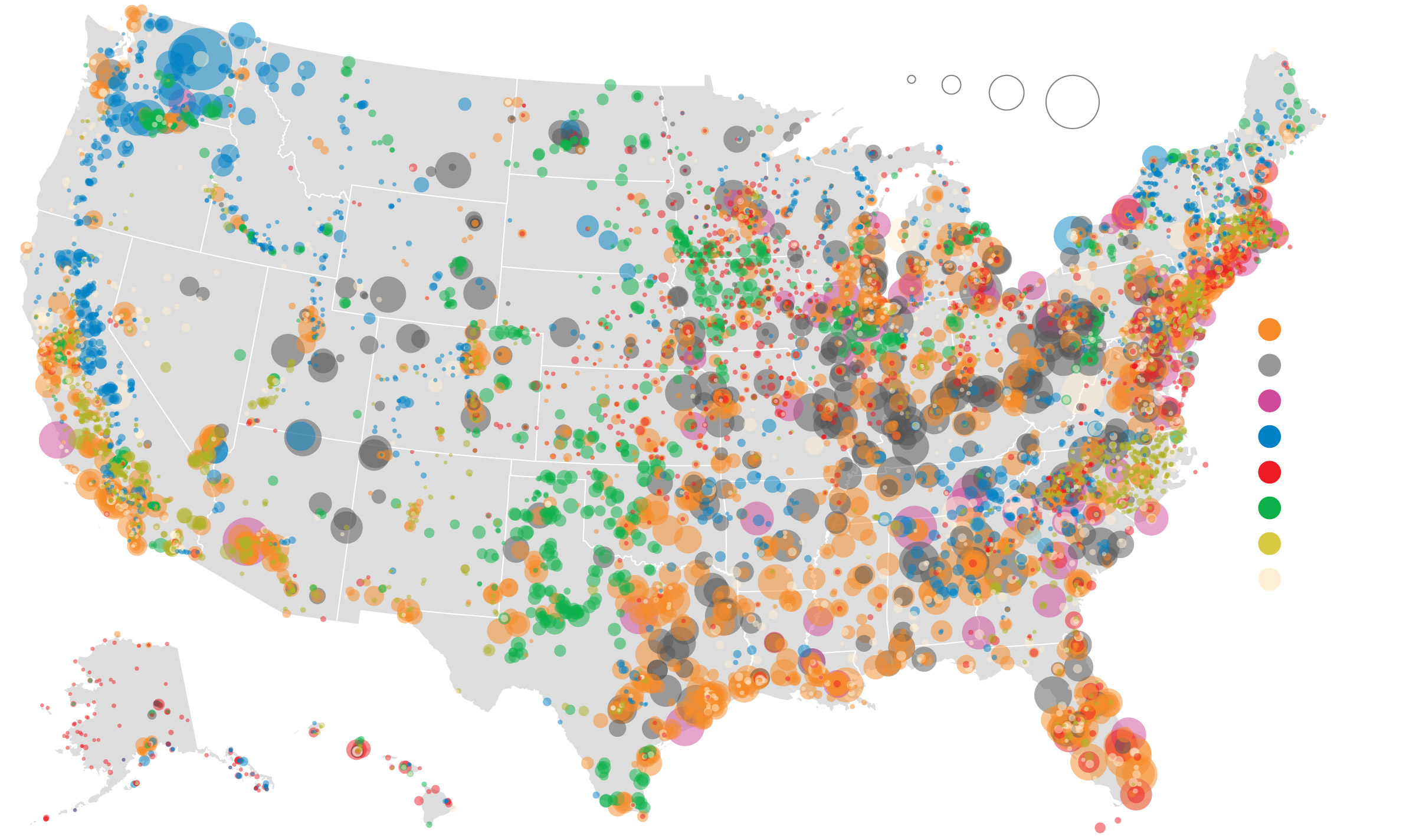
Compare the previous map to the following map of the electric grid...
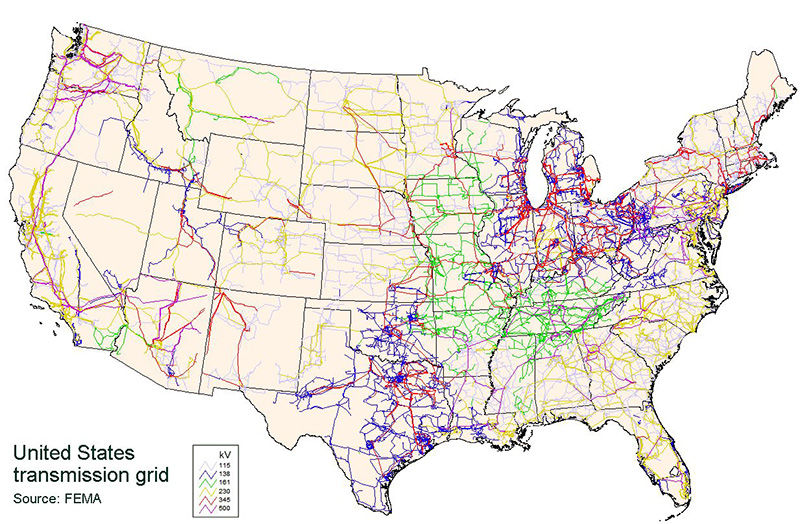
One of the things you might note is that there are very few transmission lines that go from west to east. Can you think of reasons why this is? This will become relevant later on.
Wind: Where is the energy?
Finally we get to discuss the wind! First question -- why does wind have energy? The concept we're checking on here is the idea that moving object have energy. This is the concept called kinetic energy. Kinetic means moving which makes sense since we're talking about moving air. Here is the mathematical definition of kinetic energy (KE):

You can see that, like air drag that we talked about previously, this depends on the square of the speed of the object. The important take away is that the energy in the wind goes up dramatically with wind speed. A wind speed of 10 m/s (20 mph) has 4 times as much energy as a 5 m/s wind (10 mph). Here's a plot that shows this effect visually.
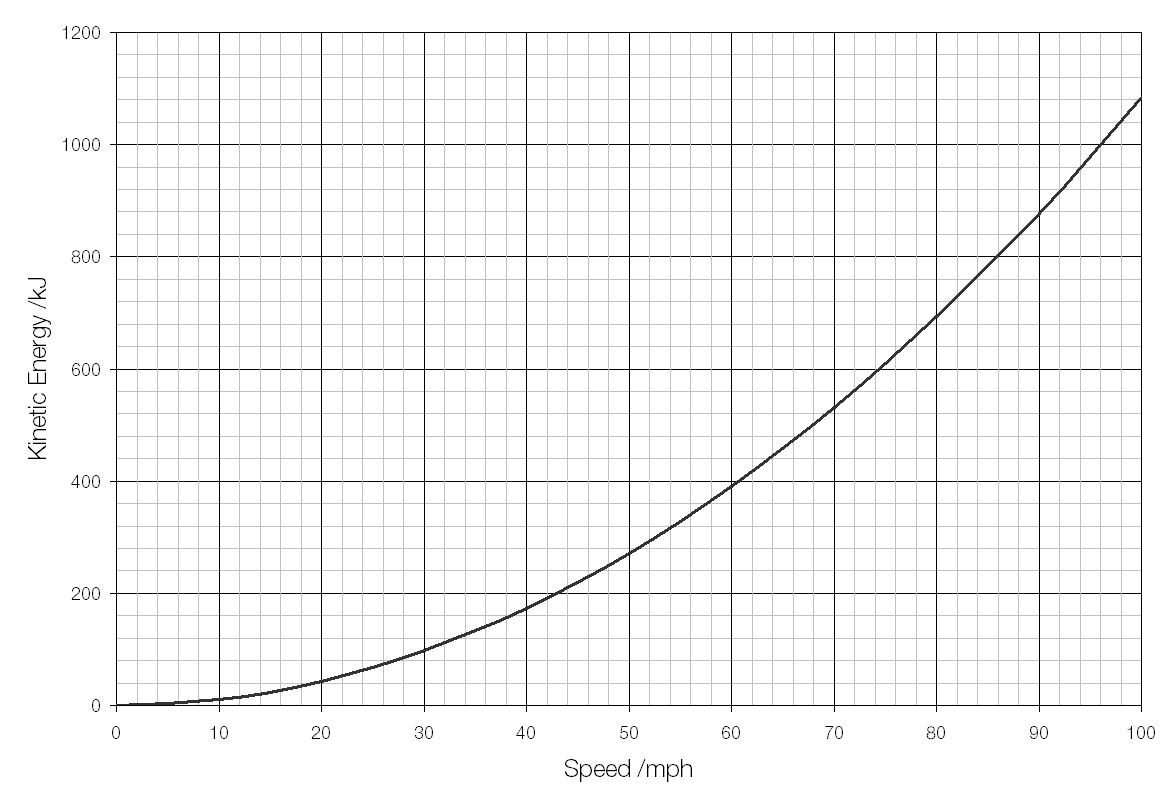
As we will see later this is why the energy generated by wind farms mostly takes place during times of high wind speed which are relatively infrequent.
Wind Energy: Can you get ALL of that kinetic energy?
This is the next important question to consider. If the energy in wind is there because it's moving is it even possible to get all of the energy out of the wind? What would the wind do if we took all of it's kinetic energy? Is it possible for the air/wind to just stop? What about the air/wind that is still 'incoming'? For this and other reasons there is a practical limit to how much of the energy in the wind we can ever hope to extract. If you want to read about it this limit is called the Betz Limit and is very close to 60% of the total energy in the wind. This limit actual applies to wind turbines like we see in the Colombia Gorge (HAWT) and not to vertical axis wind turbines (VAWT). VAWT seem to always be less efficient than HAWT but that's observational and not based on a complete theory. So -- 60% is the magic number here. Sounds better than gasoline engines but not as good as electric motors at this point.
Wind Energy: Where to build on land?
Construction projects on land are distinctly easier than the same project in hundreds of feet of water. We'll start with the idea of land based wind power. If you're looking at wind energy from a personal energy (off the grid maybe) perspective you'll get a different answer to the "Where to build?" question. For this class we're concerned with the broader society wide perspective. Seems like a good place to start would be to look at average wind speeds across the country. This map is from NREL (National Renewable Energy Laboratory in Golden CO).
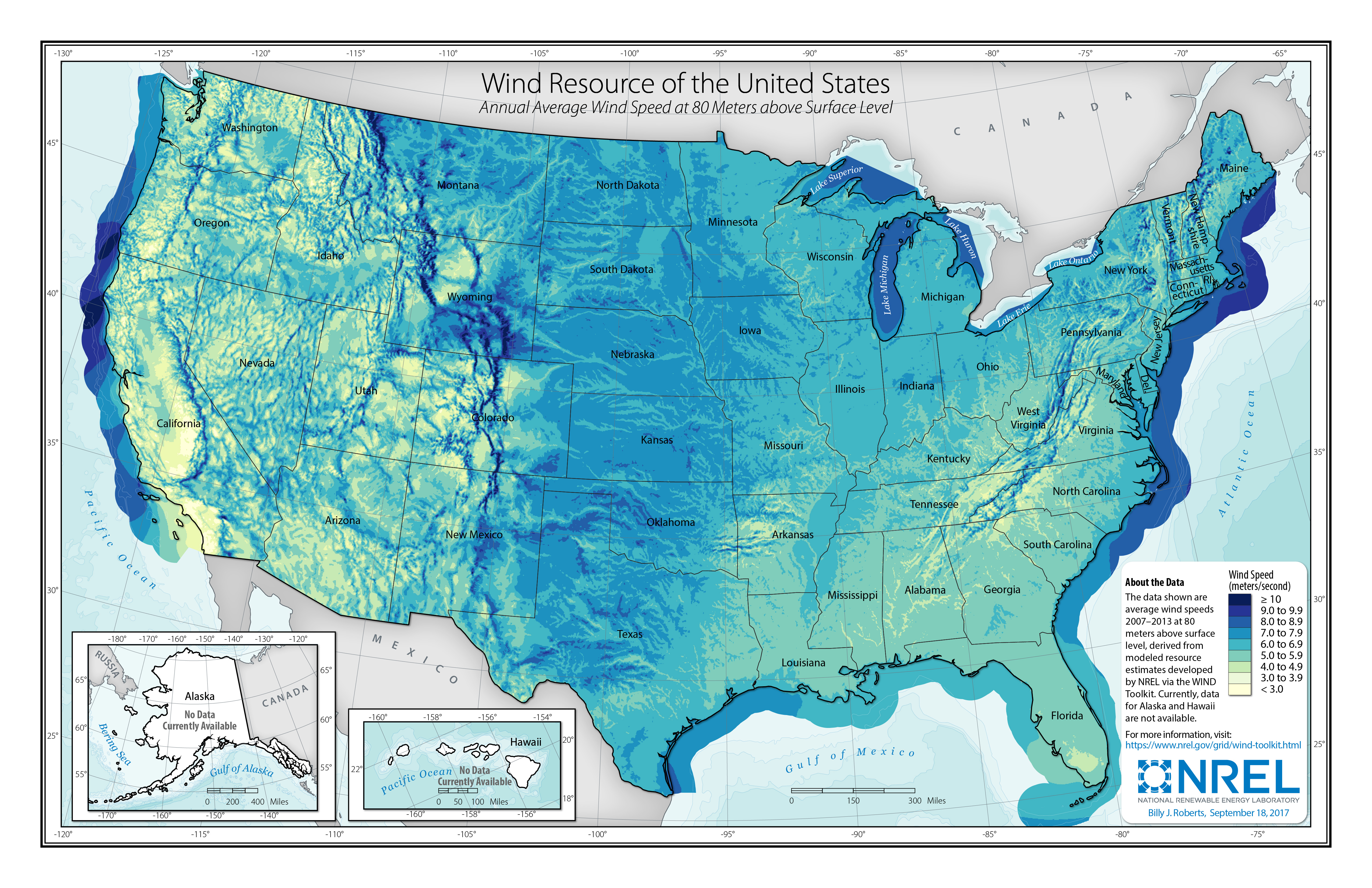
What are we looking for? In the UK wind farms are typically located where the average wind speeds are 6 m/s or higher. Do we have some of this? How much of the country looks like a good wind resource? Here's the UK map for comparison. How much of the UK looks like a good wind resource?
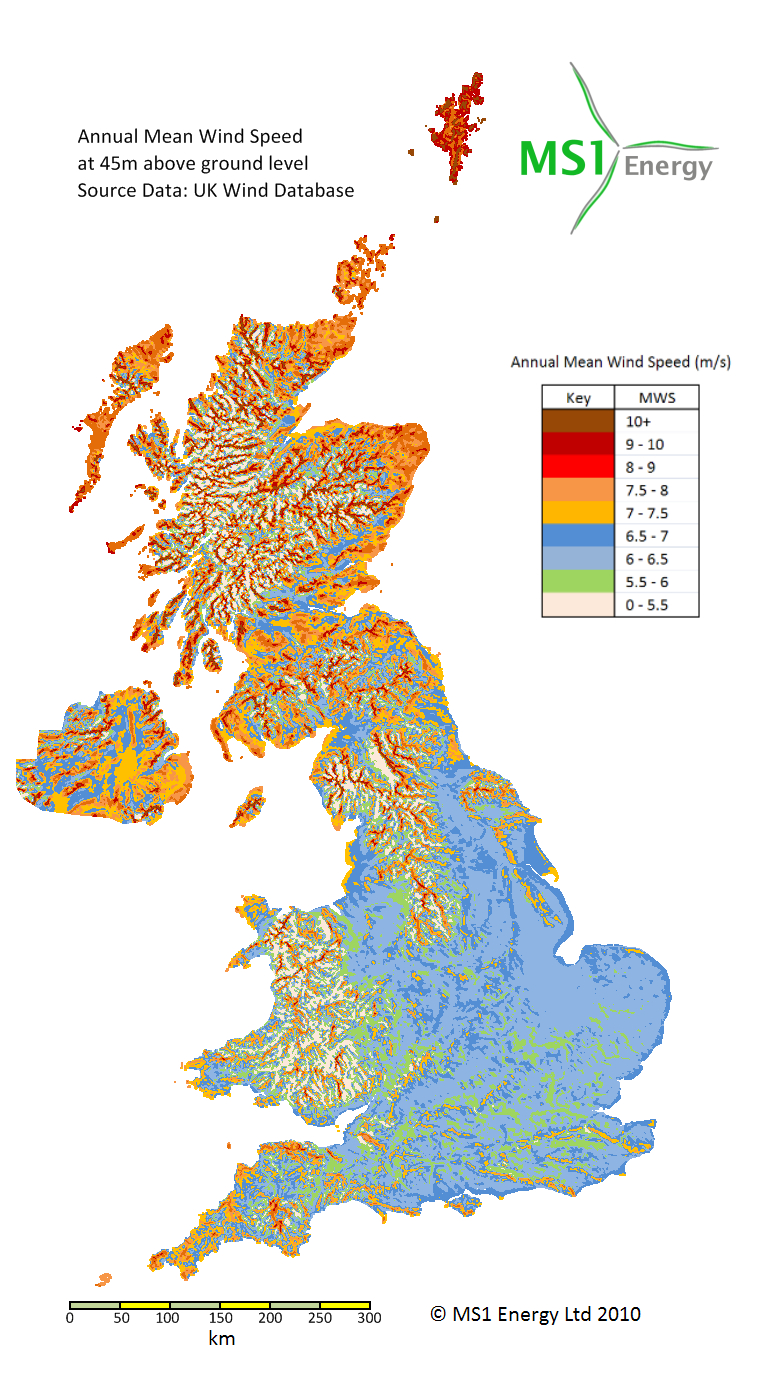
What about Oregon? Here's the map.
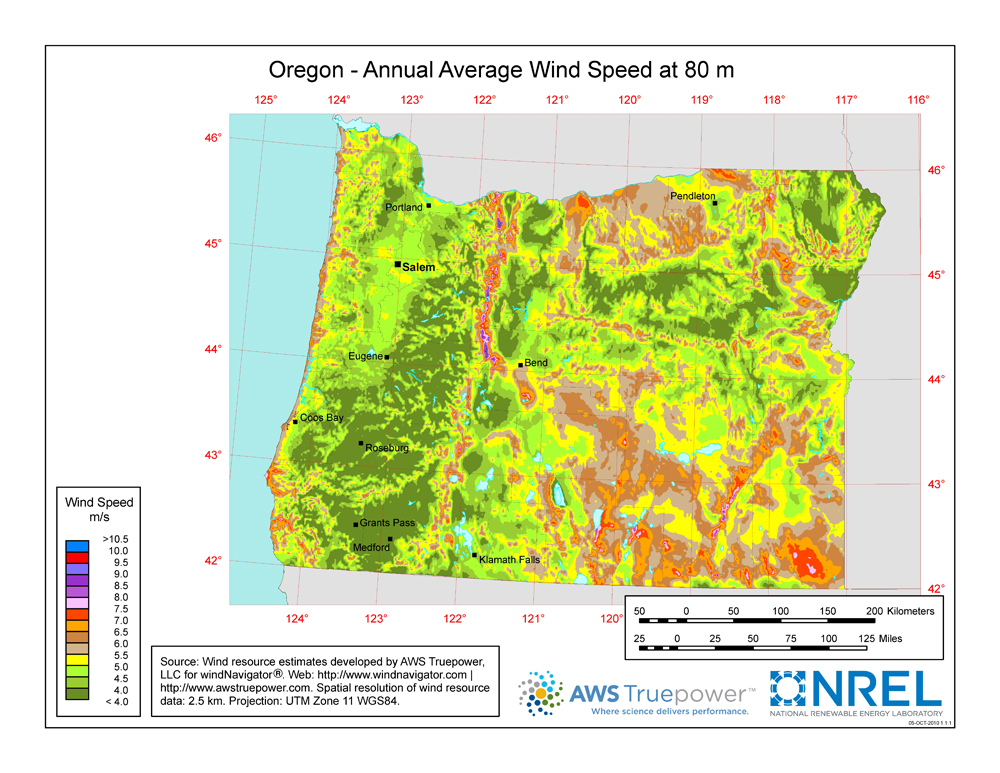
Where should we build in Oregon? Shepards Flat up by Biggs in the Columbia Gorge is at one of the red zones. There are definitely wind turbines up there. What's the other obvious choice? Are there wind turbines there? Why or why not? Look at the grid map and consider why.
no grid access to get the power to a significant market like California
HW: Wind
Ask someone who isn't in this class where in this country (which states) is there the best wind potential for wind energy. Where does the map from the National Renewable Energy Lab indicate is the answer to this question?
Wind Energy: Generation
David does some quick calculations to show that wind farms in the UK produce at about 2 W/m2. Remember this is the average over the year - day in and day out 24/7. To figure out how much power they might generate if they carpeted the UK with wind turbines David does this calculation -- be sure you understand it.

Which says what about solving the UK wind energy problem with wind power? Why does David back down and suggest only carpeting 10% of the UK with wind turbines? This is why he only projects 20 kWh/pd for wind power generation for the UK.
What About the US?
First lets check and see if David's number for wind generation (2 W/m2) seems right for the US. We'll use the Shepards Flat wind farm as a model since it's fairly recent and as we saw before it's a good energy resource. Here's the link to the Shepards Flat Wiki page.
Here are some of the important data points to dig out of the article (yes, you need to know how to do it). Annual energy generation 2000 GWh, 845 MW nameplate capacity, and 78 km2 is the area. To figure out the equivalent of David's 2 W/m2 we need to take the average rate at which energy is produced (Watts) and divide it by the area (in m2). I can get Watts by dividing the energy produced in a year by the hours in a year. Then I can divide that by the area in m2. Here's what those calculations look like.

This is a little higher than David's number from the UK. What possible explanations are there? Higher wind speeds? Area maybe underestimated? Here's a map of the wind farm which I think provides some of the answer.
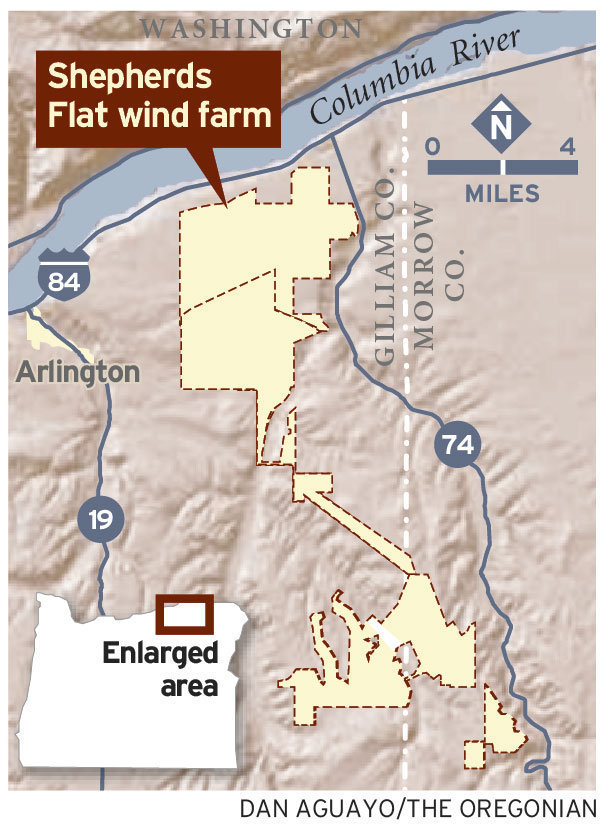
I would argue that David's number of 2 W/m2 is pretty good and maybe we are getting better at this and 3 W/m2 is not unreasonable. Since we're being optomistic we'll use the 3 W/m2.
Now we do the same calculation for the US that David did for the UK. Remember that there are 24,000 m2/p in the US.

So, if we can get 3 W/m2 out of our wind farms and we carpet the US with wind turbines there is no problem -- class done! 1700 kWh/p/d is roughly 6x what we need for ourselves! Of course if we only cover the best 10% of the area and we get more like 2 W/m2 then this number is reduced to 120 kWh/p/d which is still pretty good but doesn't quite solve our problem.
Take Home: 10% of the area of the US covered in wind turbines will produce about 170 kWh/p/d!
What are your thoughts at this point?
HW: Wind
It can be remarkably difficult to find all the data we need to determine the production of energy by other wind farms (just got lucky with Shepard's Flat I think). After digging around in the NREL data base Here are some numbers from an Oklahoma wind farm called Blue Canyon. The nameplate capacity is 75 MW and in a good month (not year!) it generates 25 GWh of energy. In a bad month it generates 15 GWh of energy. Looking at the map of the region it looks like this wind farm covers at least 30 mi2 spread through the ridges and farm country there. How many W/m2 does this facility generate? Remember that these numbers are for a month of production not a year.
Assignment: HW: Wind
Complete and assemble your solutions to all the HW problems (3) listed here showing all the steps in your solutions. Scan to a pdf and turn in on LMS. Please review HW format expectations for guidance about your homework solutions.
Reading Ahead:
Next you will read the chapter on Wind: Tech from David's book before we start the next discussion. This is a quick chapter that lays out more details about how we generate power from wind and various constraints.
